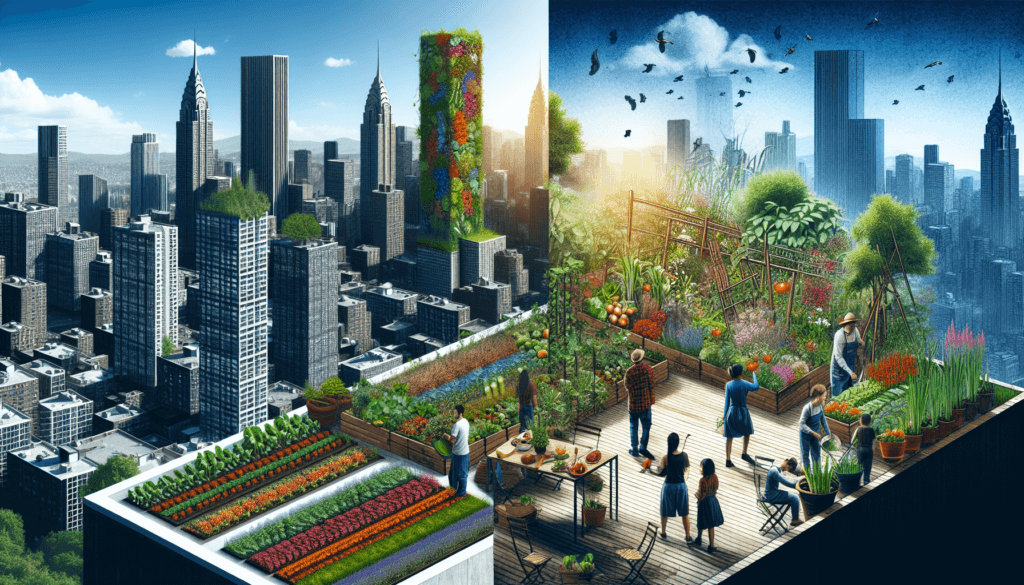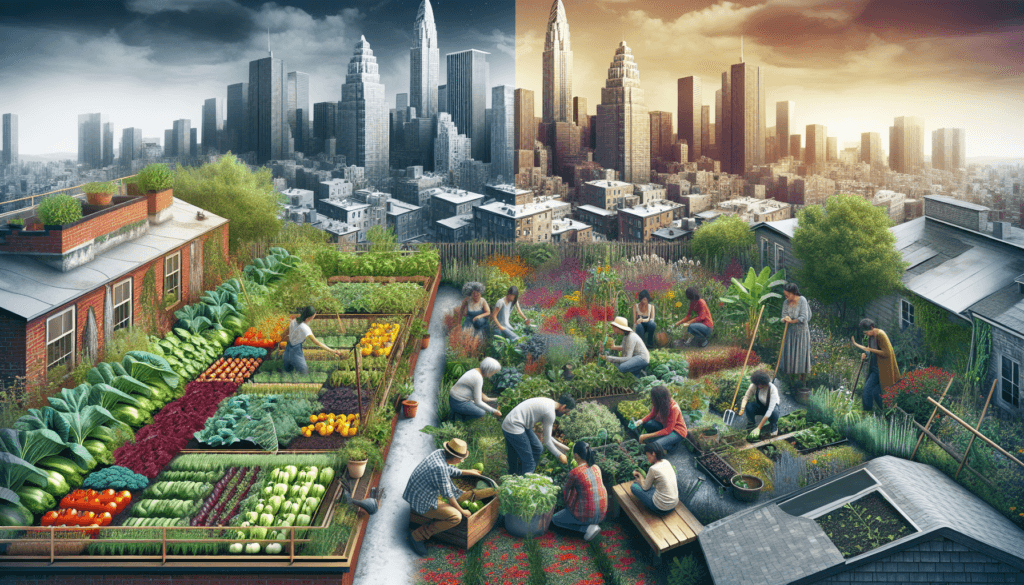Have you ever wondered about the distinction between urban farming and community gardening? While both involve cultivating plants in urban environments, there are subtle yet important differences between the two. Urban farming typically refers to a more intensive form of agriculture that aims to address food production and self-sufficiency in urban areas, often involving the cultivation of crops on a larger scale. On the other hand, community gardening focuses more on creating communal green spaces where individuals come together to grow plants, fostering a sense of community and providing opportunities for education and social interaction. Let’s explore these two practices in more detail and understand how they contribute to sustainable urban living.

The Basics of Urban Farming
Definition of Urban Farming
Urban farming refers to the practice of cultivating plants and raising animals within urban environments. It is a way to bring agriculture back into the city, utilizing small spaces such as rooftops, balconies, and vacant urban lots. Urban farming not only provides fresh fruits, vegetables, and other produce to urban dwellers but also promotes sustainability by reducing the carbon footprint associated with transporting food from rural areas.
Focus on Food Production and Sustainability
One of the primary focuses of urban farming is food production. By growing crops and raising animals in urban areas, communities can become more self-sufficient when it comes to their food supply. This is particularly important in densely populated urban areas where access to fresh and healthy food options may be limited. Urban farming also promotes sustainability by reducing food miles, minimizing the use of pesticides and fertilizers, and utilizing organic farming methods.
Incorporation of Technology
Urban farming often incorporates technology to optimize food production in limited spaces. Techniques such as hydroponics and vertical farming are commonly used in urban farming to maximize yield and make the most efficient use of space, water, and nutrients. Additionally, innovative technologies like automated irrigation systems, indoor farming systems, and IoT (Internet of Things) sensors are employed to monitor and regulate the growing conditions of crops.
Utilization of Small Spaces
One of the key factors of urban farming is its ability to utilize small spaces for food production. With limited land availability in urban environments, urban farmers make use of vertical spaces, such as walls or vertical racks, and explore rooftop farming to maximize the cultivation area. By employing creative solutions, urban farmers can grow a diverse range of crops, including vegetables, herbs, and even small fruit trees, in limited square footage.
Understanding Community Gardening
Definition of Community Gardening
Community gardening involves cultivating plants collectively within a community, be it a residential neighborhood, school, or workplace. It brings people together and fosters a sense of community. Unlike urban farming, which focuses on food production, community gardening’s primary goal is to create green spaces for the community to enjoy and learn from.
Focus on Community Engagement
The main focus of community gardening is community engagement. It aims to bring people together through gardening activities, providing an opportunity for individuals of all ages and backgrounds to collaborate, learn, and connect. Community gardens often organize workshops, events, and educational programs to promote gardening knowledge and sustainable practices among community members.
Shared Responsibility and Benefits
Instead of individuals taking ownership of specific plots, community gardens typically operate under a shared responsibility model. The management and maintenance of the garden are undertaken collectively by the community members. This shared responsibility creates a sense of ownership and encourages active participation, fostering a strong sense of community and shared success.
Promoting Green Spaces
One of the key objectives of community gardening is to create and maintain green spaces within urban areas. These green spaces offer numerous benefits to the community, including improved air quality, temperature regulation, and enhanced biodiversity. They also serve as areas for relaxation, recreation, and social interaction, bringing nature into the urban environment and promoting a healthier and more sustainable cityscape.

Differences in Location and Scale
Urban Farming in Urban Settings
Urban farming primarily takes place within urban settings, such as cities and densely populated areas. It is often carried out in small spaces, such as rooftops, balconies, or indoor environments. The focus is on utilizing limited areas of land to produce a significant quantity of food, either for personal consumption, local markets, or commercial purposes. Urban farming can take advantage of the existing infrastructure and resources found in urban areas, making it feasible and adaptable to the urban landscape.
Community Gardening in Various Settings
Unlike urban farming, community gardening can take place in a variety of settings, including residential neighborhoods, schools, workplaces, and other communal spaces. Community gardens can be established in both urban and suburban areas, depending on the availability of land and the interest of the community. While urban farming may focus on intensive food production, community gardening emphasizes creating green spaces and fostering community engagement, irrespective of the scale or location.
Variations in Scale and Size
Urban farming often operates on a smaller and more intensive scale due to the limited space available in urban environments. It may involve small-scale operations, such as herb gardens on balconies, or larger-scale initiatives, such as urban rooftop farms producing a significant amount of fresh produce. Conversely, community gardening can range from small community plots within a park to larger-scale gardens spanning several acres, depending on the size and interest of the community.
Primary Goals and Objectives
Urban Farming: Food Production and Self-Sufficiency
The primary goal of urban farming is to produce food within urban areas, ensuring a local and sustainable food supply. Urban farmers aim to reduce dependency on food imports, enhance food security, and improve access to fresh and healthy produce for urban residents. Urban farming also encourages self-sufficiency, allowing individuals, communities, and even businesses to grow their own food and become less reliant on external food sources.
Community Gardening: Community Building and Education
The main objective of community gardening goes beyond food production. Community gardens aim to build strong communities by bringing people together, fostering a sense of belonging, and promoting social interaction. They serve as educational spaces, offering opportunities for community members, particularly children, to learn about gardening, sustainable practices, and environmental stewardship. Community gardens also provide a platform for intergenerational and multicultural learning, strengthening community ties.

Ownership and Management
Collective Ownership in Community Gardening
Community gardening typically operates under a collective ownership model. The garden space is collectively owned and managed by the community members. Decisions related to garden maintenance, rules, and activities are made collectively through community meetings or designated committees. This collective ownership model encourages inclusivity, shared responsibility, and equal access to gardening resources within the community.
Ownership and Management Models in Urban Farming
In urban farming, ownership and management models can vary depending on the scale and objectives of the farm. Some urban farms are owned and managed by individuals or organizations, operating as for-profit businesses. Others may operate as social enterprises, focusing on both economic viability and social impact. In some cases, urban farms may have partnerships with local government or nonprofit organizations to address issues of land ownership and access.
Involvement of Participants
Urban Farming: Individual or Organizational Basis
Urban farming can involve individuals or organizations who take on the responsibility of farming activities. Individuals may engage in urban farming as a hobby or to supplement their food supply. Organizations, such as nonprofits or social enterprises, often lead larger-scale urban farming initiatives that aim to address food security or provide employment opportunities. In urban farming, involvement is more individual or organization-based, with participants taking on specific roles and responsibilities.
Community Gardening: Collective Effort and Collaboration
Community gardening thrives on collective effort and collaboration. It encourages all community members to participate and contribute in whatever capacity they can. People with various skill levels and knowledge of gardening can come together, share their expertise, and learn from one another. Community gardens provide an inclusive space where everyone, irrespective of age, background, or experience, can join hands in tending plants, maintaining the garden, and fostering a sense of community.

Plants and Crops
Urban Farming: Diverse Range of Plants
Urban farming allows for the cultivation of a diverse range of plants, including vegetables, fruits, herbs, and even flowers. The diversity of crops grown in urban farms is dependent on various factors, such as the space available, climate conditions, and market demand. Urban farmers often experiment with different plant varieties and growing methods to maximize yield and cater to the specific needs and preferences of the urban community.
Community Gardening: Focus on Vegetables and Herbs
Community gardening traditionally places emphasis on the cultivation of vegetables and herbs. This focus aligns with the goal of community gardens to provide fresh and healthy food options to community members. Growing vegetables and herbs also facilitates a closer connection to nature, as these plants are the basis of many people’s everyday meals. While community gardens may incorporate other plant varieties, the primary focus remains on cultivating crops that directly contribute to the community’s nutritional needs.
Infrastructure and Techniques
Urban Farming: High-Tech and Controlled Environment
Urban farming often involves the use of high-tech infrastructure and controlled environments to optimize crop production. Techniques such as hydroponics, aeroponics, and aquaponics allow for soil-less cultivation, saving space and conserving water. Urban farms may also incorporate climate control systems, artificial lighting, and monitoring technologies to create optimal growing conditions. These advanced techniques enable year-round production and ensure consistent quality, even in urban environments with limited access to natural resources.
Community Gardening: Simple and Low-Cost Techniques
Community gardening tends to rely on simple and low-cost techniques. Techniques such as traditional soil-based gardening, composting, and water-saving methods like rainwater harvesting are commonly utilized. These techniques are accessible to community members with limited resources and gardening experience. Community gardens prioritize inclusivity and aim to provide affordable and sustainable gardening practices that can be easily replicated by community members in their own spaces.

Financial Models and Sustainability
Urban Farming: For-Profit and Social Enterprise Models
Urban farming can be financially sustainable through various models. Some urban farms operate as for-profit ventures, selling their produce to local markets, restaurants, or directly to consumers. Others adopt a social enterprise model, where the farm generates revenue while also addressing social and environmental issues. These social enterprises often reinvest their profits into community programs, education, or employment opportunities, thereby promoting sustainable, long-term impact.
Community Gardening: Reliance on Donations and Grants
Community gardens typically rely on donations, grants, and volunteer support to sustain their operations. While some community gardens may generate modest revenue through produce sales, their financial sustainability heavily depends on external funding sources. Grants from government entities, foundations, or corporate sponsors, as well as community fundraising efforts, play a significant role in maintaining community gardens and supporting community programs.
Impact on the Community
Urban Farming: Economic Opportunities and Food Security
Urban farming has the potential to generate economic opportunities within communities. By growing and selling produce locally, urban farmers can create jobs, provide income-generating activities, and contribute to the local economy. Additionally, urban farming enhances food security by reducing reliance on external food sources and ensuring access to fresh and nutritious food for urban dwellers. It also empowers communities to take control of their own food production and distribution, reducing vulnerability to food shortages and price fluctuations.
Community Gardening: Social Cohesion and Well-Being
Community gardening promotes social cohesion by bringing diverse community members together, fostering relationships, and creating a sense of belonging. By working collectively towards a common goal, community members strengthen their bonds and develop a shared identity. Engaging in gardening activities has been shown to have positive impacts on mental and physical well-being, reducing stress, and improving overall quality of life. Community gardens also contribute to improved aesthetics and green spaces within neighborhoods, enhancing the overall livability and well-being of the community.
In conclusion, while both urban farming and community gardening revolve around cultivating plants, they differ in their primary objectives, scale, ownership models, participant involvement, and impacts on the community. Urban farming focuses on food production, sustainability, and incorporating technology to maximize yields in limited spaces. On the other hand, community gardening emphasizes community engagement, shared responsibility, and the creation of green spaces for educational and social purposes. Understanding these differences allows individuals and communities to choose the approach that aligns best with their needs and goals, contributing to a more sustainable and inclusive urban environment.


